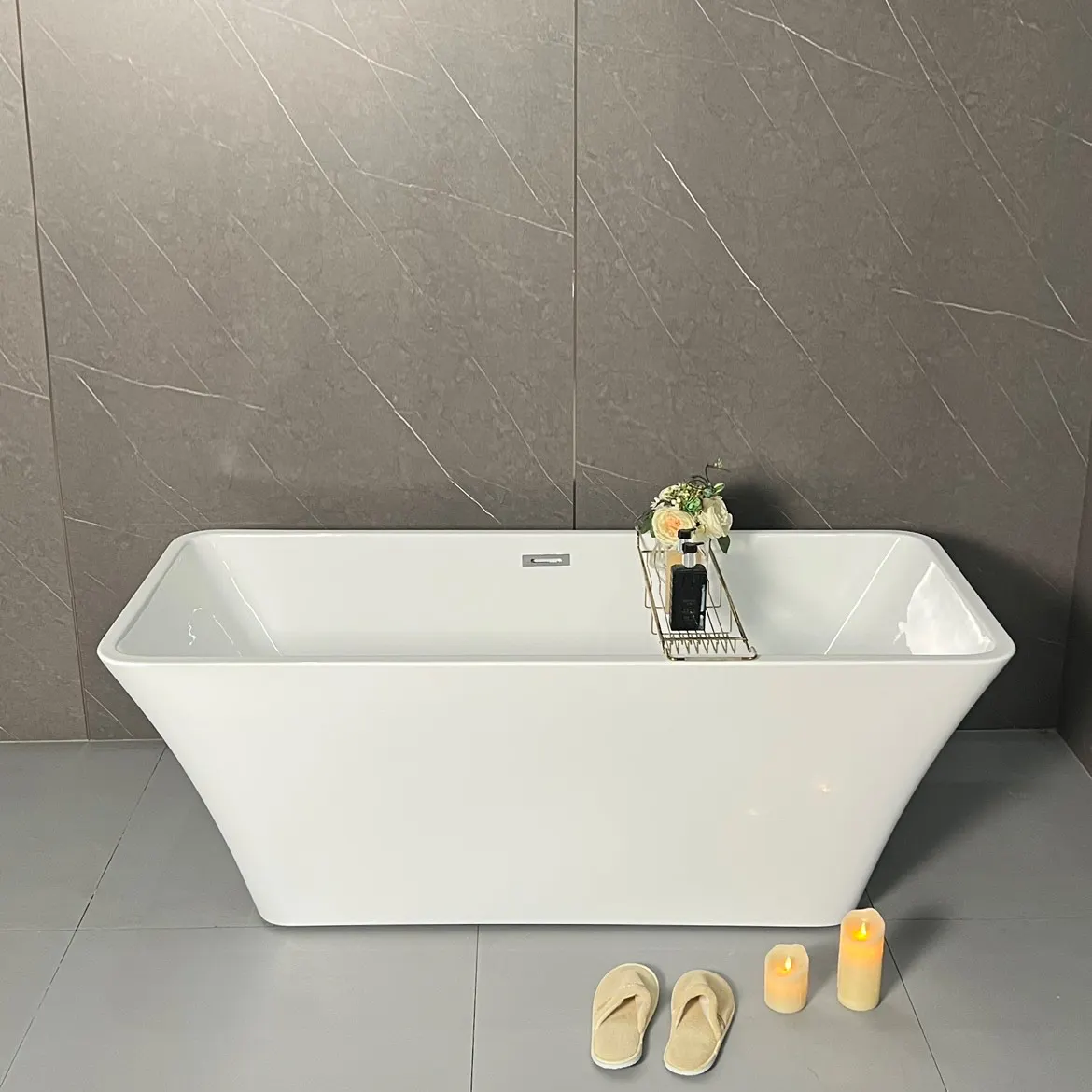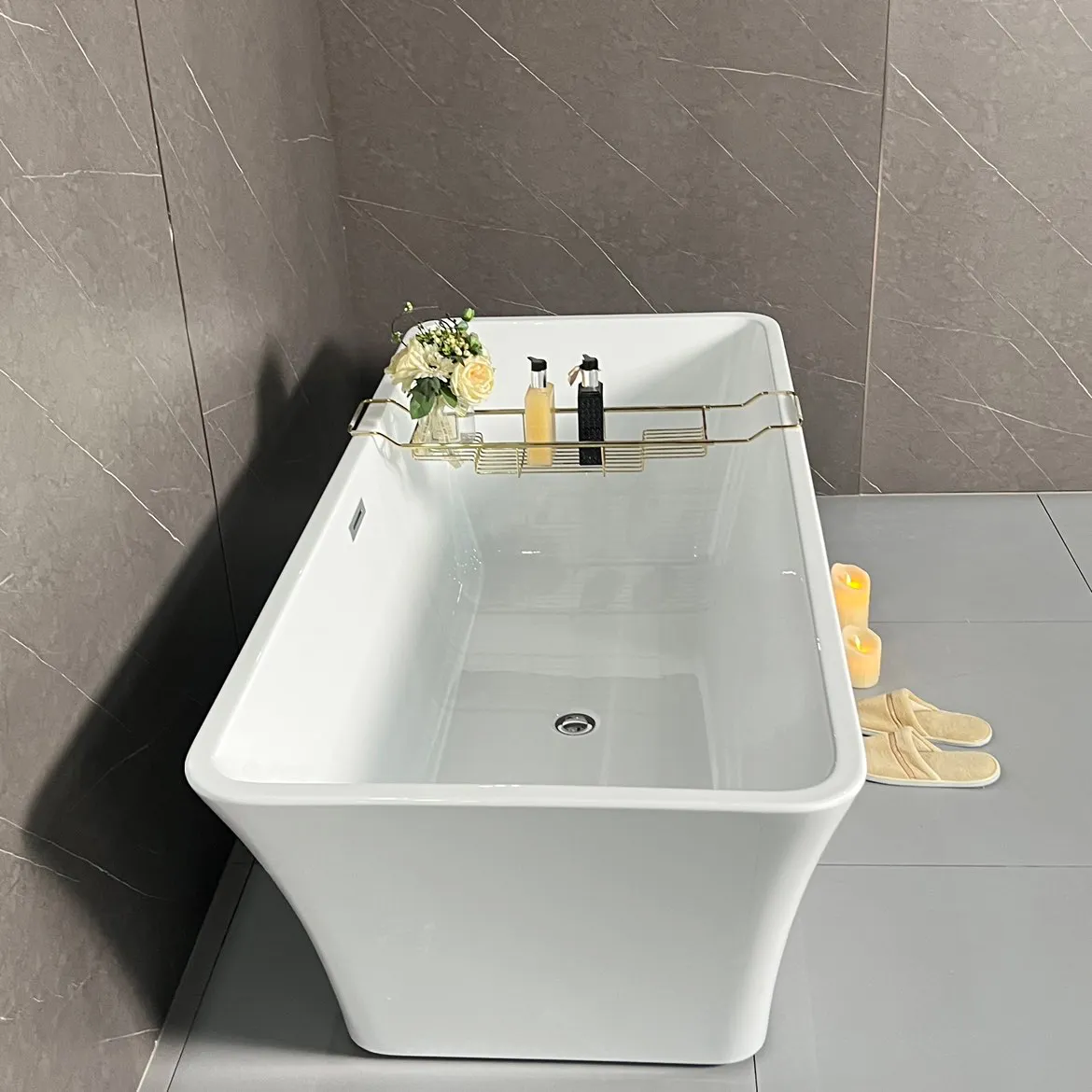Essential Tools for Freestanding Bathtub Maintenance
Non-Abrasive Cleaners for Gentle Scrubbing
Non abrasive cleaners play an important role in keeping freestanding bathtubs looking good over time, especially when dealing with materials such as acrylic and porcelain that tend to scratch easily. These kinds of cleaners help preserve the shine on the surface while getting rid of dirt and grime effectively. Mild dish soap works well for most people along with vinegar based cleaners since they contain gentle components that don't damage surfaces. When applying these products, grab a soft cloth or sponge instead of anything rough, and go in circles rather than straight lines so there aren't any unsightly marks left behind. Cleaning about once every seven days tends to work best, particularly following periods of frequent usage, helping stop soap scum and minerals from building up inside the tub. Regular maintenance with proper cleaning solutions keeps the bathtub shining brightly without harming its overall condition or lifespan.
Microfiber Cloths and Soft Sponges
For keeping a bathtub looking good, microfiber cloths and gentle sponges really matter. They work well because they grab onto dirt particles and wipe away dust without causing damage. Especially matters for those delicate surfaces such as acrylic or porcelain tubs since even small scratches become noticeable pretty quickly. When shopping around for cleaning supplies, go for quality microfiber cloths with tight weaves that actually catch dust instead of just pushing it around. Soft sponges that won't scratch the surface also help maintain that beautiful look over time. What makes microfiber cloths worth investing in? They last longer than cheaper alternatives. Most can handle several washes before they start losing their effectiveness. Want to get the most out of them? Wash microfiber cloths alone in cold water with a gentle detergent. Stay away from fabric softeners though, as these tend to coat the fibers and reduce their ability to trap dirt. Taking proper care extends the life of both cloths and sponges, so they remain valuable additions to any bathroom cleaning routine aimed at preserving that elegant bathtub appearance.
Daily Cleaning Routine for Your Freestanding Bathtub
Rinsing After Each Use to Prevent Buildup
Getting into the habit of rinsing the bathtub after every use stops soap scum and mineral deposits from building up over time, something that can cause real problems down the road. Takes hardly any time at all really, but makes such a big difference for keeping the tub looking good. Just spend about a minute after getting out of the bath, and those soaking tubs stay in much better shape than they would otherwise. Warm water works best for rinsing because it breaks down residue faster, so the freestanding tub lasts longer without needing constant attention. Once this becomes part of regular bathroom maintenance, the surface stays protected and those deeper cleaning sessions become way less stressful when needed.
Wiping Down Surfaces to Maintain Shine
Regularly wiping down bathtub surfaces with a soft cloth helps keep them looking shiny and lasts longer overall. Gently going in circles works best, especially around those hard to reach corners where grime tends to hang out. After doing this quick clean each day, maybe try one of those gentle shine boosters made for freestanding tubs. They don't scratch porcelain or acrylic surfaces but still give that nice glossy finish. Stick with this basic routine and the bathtub stays beautiful without all that hassle. Most people find their bathroom just feels better when the tub looks good, not to mention it actually functions properly too after all these years.

Weekly Deep Cleaning Techniques
Vinegar Solutions for Natural Cleaning
White vinegar works great for cleaning freestanding bathtubs and gets rid of stubborn grime without all those harsh store bought cleaners. The acid in vinegar does most of the work naturally, keeping things clean while being gentle on surfaces. To make a simple cleaning solution, mix half vinegar with half warm water in a spray bottle. Spritz this mixture onto the bathtub about once a week, let it sit for a few minutes, then wipe away with a soft cloth. Works well on acrylic and porcelain tubs generally. But watch out if someone has a natural stone bathtub at home since the vinegar can actually eat away at the finish over time. Most people find that regular applications keep their tub looking fresh and free from stains, making it look nicer in the bathroom overall.
Addressing Hard Water Stains Effectively
Those hard water stains really mess with how freestanding bathtubs look, leaving behind those ugly mineral deposits that just make the whole thing look dull and worn out. Most of the time these problems come from minerals building up in the water, and after a while they get pretty tough to clean off without knowing what works best. A good old fashioned combo of baking soda mixed with vinegar does wonders though. The baking soda scrubs away at the grime while the vinegar helps break down those stubborn mineral deposits. There are plenty of commercial cleaners out there too if regular household stuff doesn't cut it for particularly bad cases. Want to stop this from happening again? Installing a water softener system makes sense long term, or alternatively running some citric acid solution through the pipes periodically keeps those pesky hard water effects from taking hold. Either way, keeping an eye on things means the bathtub stays looking nice instead of getting all crusty and gross over time.
Preventing Damage to Soaking Bath Tubs
Avoiding Harsh Chemicals and Abrasives
Soaking bathtubs get damaged pretty easily when exposed to harsh chemicals and abrasive cleaners. These products eat away at finishes and leave behind unsightly scratches that nobody wants to see. For anyone looking after their bathtub, knowing what goes into cleaning products matters a lot. There are safer options out there though. Baking soda works wonders on most stains, white vinegar cuts through grime without hurting surfaces, and even regular dish soap can handle everyday dirt if it's gentle enough. When buying bathroom cleaners, always check for labels that say non-abrasive and steer clear of anything containing strong acids or ammonia. Before grabbing that bottle off the shelf, take a moment to read ingredients carefully. Test any new cleaner on a tiny spot first just to be sure it won't cause problems later. And forget about those metal scrubbing pads or stiff bristled brushes they sell in stores. Stick with soft cloths instead. Following this approach helps protect tub surfaces over time so they stay looking good for years rather than getting ruined prematurely.
Protecting the Bathtub Finish from Scratches
Freestanding bathtubs get scratched all the time when people accidentally drag something sharp across them or clean with dirty tools that leave marks behind. Keeping an eye on those cleaning supplies and making sure they stay out of reach near the tub area goes a long way toward avoiding those annoying little scuffs. When it comes to regular upkeep, stick to gentle stuff like soft sponges or microfiber cloths rather than anything abrasive. Some folks swear by certain maintenance products specifically made for bathtubs. These coatings form a protective layer that actually makes the surface harder to scratch, which helps keep that beautiful look intact. Follow these simple steps and most freestanding bathtubs will stay looking great through many baths and countless guests over the years.
Troubleshooting Common Maintenance Issues
Repairing Minor Chips or Cracks
Like most things around the house, freestanding bathtubs can get little chips or cracks when something heavy falls on them by accident. Small chips happen when folks drop stuff, whereas bigger cracks tend to form over time from regular wear and tear plus changes in temperature. Fixing these little problems early stops them from getting worse and keeps the bathtub looking good. DIY types will find plenty of repair kits available at hardware stores that handle minor fixes. Most contain epoxy or acrylic products designed to blend in with whatever color the tub originally was. While these work okay for small jobs, they aren't permanent solutions. When there's serious damage or the whole structure feels weakened, calling in someone who knows what they're doing makes sense. Professionals have the right tools and experience to fix things properly without causing more trouble down the road.
Fixing Drainage Problems Promptly
Water drainage issues tend to pop up quite often with those freestanding tubs we love so much. Ignoring them just leads to bigger headaches down the road with potential water damage and all sorts of messes. Most of the time, slow draining or puddles forming around the tub happen because something's blocking the pipe - usually hair clumps, leftover soap scum, maybe even little bits of stuff kids drop in there. When this happens, start by looking for anything obvious stuck in the drain. A good old fashioned plunger works wonders sometimes, or grab a drain snake if needed. Still not working? Might need to take off that drain cover and give the whole area a thorough cleaning. For smaller blockages, mixing baking soda and vinegar together before flushing it down can do the trick. Want to stop these problems from happening again? Invest in a decent drain guard to catch hair and other debris before they cause trouble. Regular cleanings every few months will make sure everything keeps running smoothly and keeps our bathrooms looking nice and dry instead of becoming soggy disaster zones.
Seasonal Maintenance Tips for Longevity
Checking Caulking and Plumbing Annually
Getting into the habit of checking the caulking and plumbing on that freestanding bathtub once a year makes all the difference when it comes to stopping leaks and saving money on big repair bills down the road. Most folks tend to forget about this until there's already water damage happening somewhere unexpected. Start with looking at the caulking along the tub edges. Keep an eye out for cracks, weird color changes, or places where it's starting to come away from the surface. Replacing old caulk keeps things sealed properly so water doesn't sneak into walls or floors where it shouldn't be. Don't neglect the plumbing either. Look for damp patches, musty smells, or those telltale greenish growths that show up in corners. These are red flags that something might be wrong underneath the surface even if nothing looks obviously broken at first glance.
Early detection of problems helps extend the life of bathtubs while avoiding costly fixes down the road. A good maintenance routine starts with cleaning around the caulk and pipes, followed by looking closely at any suspicious spots. After that, give questionable areas a gentle press to see if there are weak points hiding beneath the surface. Taking care of small issues before they become major ones keeps bathtubs looking great throughout the seasons without needing constant intervention.
Winterizing Outdoor Freestanding Bathtubs
Getting ready for winter is really important if you want to protect that outdoor freestanding bathtub from getting damaged by freezing temperatures and make sure it lasts longer. The main thing here is making sure everything gets drained properly. Take the time to remove all water not just from the tub itself but also from those pipes running underneath. Sometimes folks forget about the small hidden areas where water can get trapped. For good measure, grab an air compressor and give those pipes a thorough blast to push out any leftover moisture that might cause problems when temps start dropping below freezing point. Once everything's dry inside, wrap up the whole setup with a heavy duty tarp that actually stands up to harsh weather conditions. Regular old tarps won't cut it during heavy snowfall or strong winds so invest in something decent quality. This extra layer will keep snow accumulation at bay while preventing ice buildup which could crack the porcelain finish over time.
Winterizing helps prevent expensive fixes caused by freezing damage, which makes all the difference when temperatures drop below zero. Keeping bathtubs in good shape extends their lifespan considerably, so people get more value out of what they already own. Many folks worry about spending too much time on winter prep work, but honestly most of these tasks aren't complicated at all. The savings down the road usually outweigh whatever hassle there might be upfront. For those unsure where to start, checking the manual provided by whoever made the tub or getting help from someone who knows what they're doing can provide clarity. Every model has slightly different requirements after all.
FAQ
What are the recommended non-abrasive cleaners for freestanding bathtubs?
Recommended non-abrasive cleaners for freestanding bathtubs include mild dish soap and vinegar-based solutions, which effectively clean without scratching the surface.
How often should I rinse my freestanding bathtub to maintain its condition?
It is advised to rinse your freestanding bathtub after each use to prevent soap scum and mineral deposit buildup.
Can vinegar be used on all types of freestanding bathtubs?
Vinegar is effective on materials like acrylic and porcelain, but caution should be taken with natural stone bathtubs as vinegar's acidity might damage them.
How can I prevent scratches on my bathtub?
Prevent scratches by using soft sponges or microfiber cloths for cleaning and avoiding contact with sharp objects.
What is the best way to address hard water stains in freestanding bathtubs?
Mix baking soda and vinegar for a natural solution, or opt for commercial descaling products for stubborn stains.
Table of Contents
- Essential Tools for Freestanding Bathtub Maintenance
- Daily Cleaning Routine for Your Freestanding Bathtub
- Weekly Deep Cleaning Techniques
- Preventing Damage to Soaking Bath Tubs
- Troubleshooting Common Maintenance Issues
- Seasonal Maintenance Tips for Longevity
-
FAQ
- What are the recommended non-abrasive cleaners for freestanding bathtubs?
- How often should I rinse my freestanding bathtub to maintain its condition?
- Can vinegar be used on all types of freestanding bathtubs?
- How can I prevent scratches on my bathtub?
- What is the best way to address hard water stains in freestanding bathtubs?

